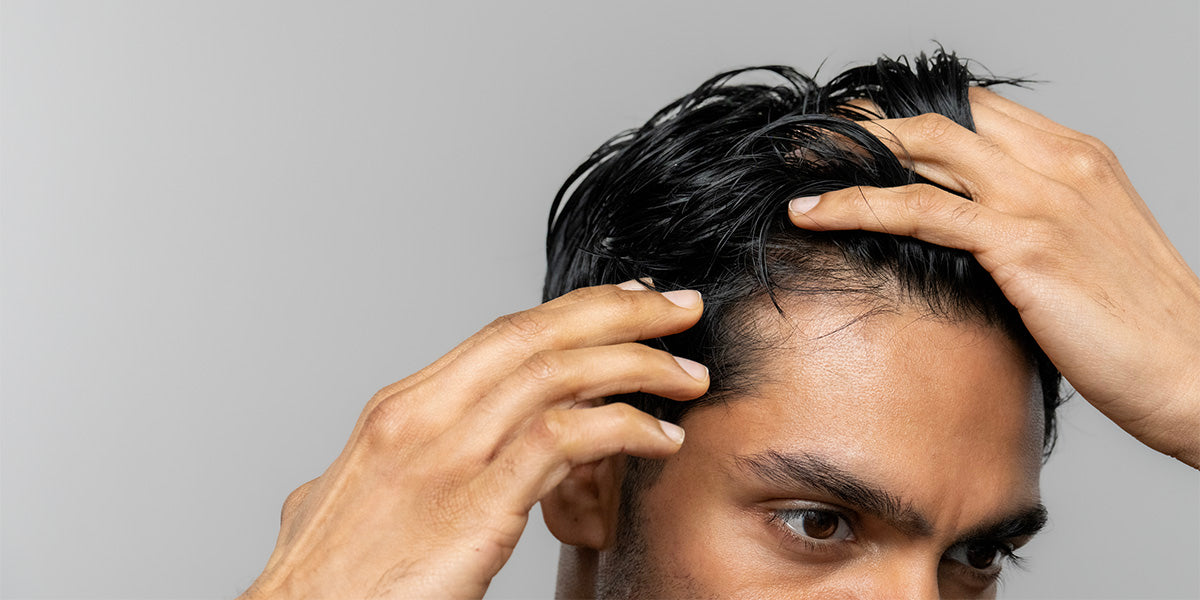If you have noticed a change in your hairline and have taken to google for some answers, you’ve probably come across the term ‘mature hairline’. Whilst it may be the answer you’re hoping for, ‘mature hairline’ can be a misleading term that may lead to a delay in men seeking early medical intervention for their hair loss.
Let's take a closer look at where this term originated from and the true mechanisms behind a receding hairline.
Does a mature hairline exist?
Countless articles online claim that a mature hairline is a natural part of ageing that occurs with the hair at the temples of the forehead moving back a couple of centimeters and shouldn’t be a cause for concern. Yet there appears to be no literature to support this terminology and it could be endangering your hair to discount hair loss as a ‘mature hairline’.
Any change in the hairline should ring alarm bells and we recommend you speak to a medical professional at the first sign of hair loss. Androgenetic alopecia, more commonly known as male pattern baldness is the most common form of hair loss which will often begin as a receding hairline. It is primarily caused by high levels of a hormone known as dihydrotestosterone (DHT) at the scalp, which can cause miniaturization of the hair follicles. This shrinkage of the follicles leads to production of thinner and more brittle strands of hair. Eventually, the follicles may be unable to produce any hair, leading to balding.
Whilst the term ‘mature hairline’ is not recognized amongst the scientific community, there can be varying degrees of androgenetic alopecia and some people may be lucky enough to experience very slow progression of hair loss. This is likely where the term originated from. Some men can be lucky enough to experience a slight receding hairline without the other typical signs of male pattern baldness, such as the development of hair loss at crown. But it’s likely that DHT is still the primary culprit.
Because of the varying presentations and progression that can be seen with androgenetic alopecia, a standardized scale has been developed. This is known as the Norwood scale (Norwood, 1975).
The Norwood scale describes the progression of hair loss, moving through types 1-7. Type 1 describes minimal or no recession of the hair line, whilst type 7 describes the most severe stage of hair loss, with the front and top of the head completely bald and hair remaining only on the back and sides of the head. The usual progression between these stages tends to happen in a similar fashion for most people. Hair loss will begin at the temporal region of the forehead first and hair loss at the crown tends to develop later. Around type 4 of the Norwood scale, hair loss begins to develop on the crown of the head and both the frontal and crown areas of balding will continue to progress, until there’s no longer any hair separating them.

What can I do about my receding hairline?
If you are lucky enough to only have slight hair loss at the temples with little progression, treatment is likely to be effective for you, especially with early intervention and there are many options available. There are currently two FDA and Health Canada approved drugs for hair loss, as well as other effective medications that may be prescribed off-label. Finasteride and minoxidil have different mechanisms of action and could be considered.
Minoxidil
Minoxidil belongs to a group of medications known as antihypertensives, which means they can lower blood pressure. Topical minoxidil is also approved for treating hair loss. Whilst the exact mechanisms behind its action for hair loss are not completely known, we do know that minoxidil causes the blood vessels to relax, which can improve the supply of oxygen and nutrients to the scalp (Suchonwanit et al, 2019). It’s also believed that minoxidil can prolong the active growth stage of the hair cycle, known as the anagen phase. Both factors contribute to promoting hair growth and stopping hair loss.
DHT blockers
DHT blockers such as finasteride on the other hand, is a DHT-blocking drug which aims to lower DHT levels at the scalp, preventing shrinkage of hair follicles. Dutasteride is a similar drug used for androgenetic alopecia, differing slightly by acting on an additional version of the enzyme that converts testosterone into DHT. However, dutasteride is not yet approved for hair loss by the FDA or Health Canada.


You don't have to accept hair loss. Get ahead of it.
Treatments that lower DHT can help address hair loss before it's too late. Talk to a doctor today.
Hair loss medication can come in different forms, including oral drugs and topical solutions that can be directly applied to the scalp. XYON’s SiloxysSystem™ Gel, uses a patented technology to treat hair loss by releasing medication to the affected hair follicles in a slow and targeted manner. It is also designed to help minimize the amount of drug that enters the bloodstream, which may help to minimize side effects of the medication.
Medications for hair loss can also be compounded orally, meaning that they are combined with other ingredients to optimize hair growth benefits. XYON combines a low dose of minoxidil with vitamin D in an oral tablet. Through combining these two ingredients, benefits can be gained from vitamin D supporting normal development of hair cells and protein production, as well as helping to regenerate hair follicles, whilst the lower dose of minoxidil may decrease the risk of side effects associated with oral minoxidil use.
Mature vs. receding hairlines: takeaway
If you notice a change in your hairline, it is more than likely that you are experiencing a receding hairline to some degree and this is almost always caused by androgenetic alopecia. The good news is, there are many effective treatment options available, but early intervention is key. Seeking medical advice at the first sign of hair loss may be the difference in preventing any further progression and potentially reversing some of your hair loss.
References List:
Suchonwait, P., Thammarucha S., Leerunyakul, K. (2019). Minoxidil and its use in hair disorders: a review. Drug design, Development and Therapy, 13, 2777-2786. https://doi.org/10.2147%2FDDDT.S214907




